Budapest to Amsterdam 2022
Main River
The Main is the longest tributary of the Rhine. It rises as the White Main in the Fichtel Mountains of northeastern Bavaria and flows west through central Germany for 525 kilometers (326 mi) to meet the Rhine below the town of Rüsselsheim.
October 7
As we sail away from Bamberg, and down the Main River, we travel past farmyards and small towns.


















Before dinner, we always have our port talks, and today I brought a couple of nice bottles of Smoke Beer to the lounge with me. I wanted to share some of that smoky flavour with some of those that hadn't had a chance to taste it while in town. Some liked it, some hated it... "it tastes like bacon", "it tastes like a campfire", "it tastes like an ashtray", regardless, it keeps getting better with every drink.


After another great dinner we stayed up late in the lounge until they kicked us out, so the staff could get some sleep.
October 8
Würzburg, Germany
We were expected to arrive in Würzburg around noon, and we had opted to do an excursion to Rothenburg ob der Tauber, so when we woke up and we had arrived early in Würzburg, we took the opportunity and jumped off the ship to wander the town.




The first thing you notice in Würzburg is the towering 13th century Marienburg Fortress overlooking the town. Originally, there was a celtic palisade castle at this site. In 704 AD the first Würzburg church was erected here. At the beginning of the 13th century fortifications were built around the church. The fortress was expanded and renovated several times during the Renaissance and Baroque periods.




Next to it on the hillside is the 18th century Käppele Sanctuary. The Käppele ('Little Chapel') is the commonly used name for the Wallfahrtskirche Mariä Heimsuchung ('Pilgrimage Church of the Visitation of Mary').




Our first stop is the beautiful old bridge (Alte Mainbrücke). The bridge was erected from 1473 to 1543 replacing an old Romanesque bridge. The characteristic 12 statues of saints were added around 1730. The pedestrianized bridge links Würzburg's old town with the former fishermen's quarter on the left bank of the Main river.






It was a great opportunity to be on the bridge when the only people we had to worry about was those that were commuting to work, and the hundreds of tourists that would be packing the bridge later in the day.








From the bridge we wandered into the old town area.





The Grafeneckart is the oldest part of the Würzburg town hall. It has a Romanesque tower and the 13th-century Wenceslas Hall, the oldest secular room in the city. Only the Grafeneckart and the gable front of the Red Building survived a hail of bombs on March 16, 1945.











Würzburger Cathedral is a Roman Catholic cathedral dedicated to Saint Kilian. The present cathedral was built from 1040 onwards by Bishop Bruno of Würzburgis. It likely was the third church on the site: the previous two, built in about 787 and 855, were respectively destroyed and severely damaged by fire.



Neumünster is a Romanesque cathedral dating back to the 11th century. Construction started in 1377 and was finished in 1480 with the erection of a church tower.




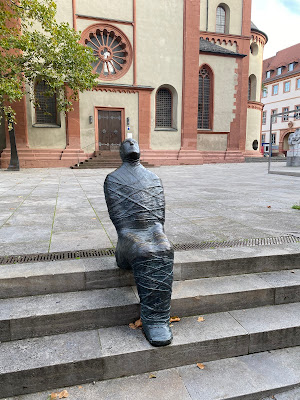




of course when we saw a little bakery, we had to stop for some breakfast treats.
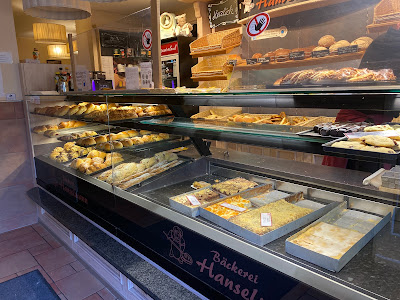

Residenzplatz is a magnificent Baroque palace, it was created under the patronage of the prince-bishops Lothar Franz and Friedrich Carl von Schönborn. It was built and decorated in the 18th century by an international team of architects, painters, sculptors and stucco-workers from 1720 to 1780.




The exterior of the palace was impressive, but the inside was a-maz-ing.








The adjoining church was jaw dropping with it's details.


The back of the palace contains a large variety of gardens.





















From the Residenz we made our way back through the streets towards the ship.









Marienkapelle (St. Mary's Chapel) is a late Gothic hall church. The construction started in 1377 and was finished in 1480 with the erection of a church tower. Elaborate ornamentation, especially in the arches of the doorways (figures of Adam and Eve by Tilman Riemenschneider). The Chapel was heavily damaged during World War 2 and was restored.








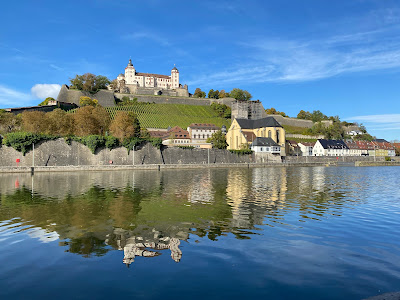

After a nice morning of exploring, we got back in time for lunch before leaving by bus to Rothenburg Ob der Tauber.
Rothenburg ob der Tauber, Germany
It's about an hours drive to Rothenberg, from Würzburg, some of it scenic, and some of it not. The bus didn't take advantage of the unlimited speeds on the Autobahn.




In Würzburg we see a Lamborghini, in Rothenberg we see an old Karrmen Ghia
Rothenberg was one of the cities that we had traveled to before, but it was such an amazing city we knew we had to come back again. The name "Rothenburg ob der Tauber" is German for "Red castle above the Tauber", it is one of only three towns in Germany that still have completely intact city walls, the other two being Nördlingen and Dinkelsbühl, also both in Bavaria.
The reason that the town is so historically intact is that in 1945 the American's negotiated with the mayor to not damage the town if they didn't defend it. The town was given up to the Americans without a fight, directly against Hitler's orders.
The first portion of the tour was guided as we walked through the cobble stone streets to the town center.







Probably one of the most famous and photographed/painted intersections in Germany.





Just a couple examples of artwork available online


Franconian wines are known for their unusual bottle shape (short and round) that is known as a “Bocksbeutel”, the term actually means "ram's scrotum", which is supposed to be of similar shape as the bottle. .

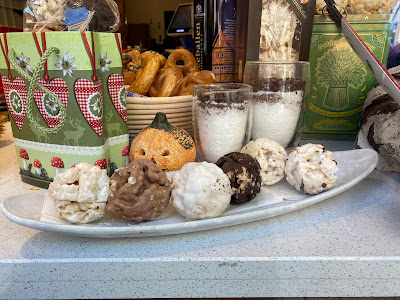
Almost as funny, is when the guide says we'll be able to sample the famous Rothenburg snow-balls, a nice pastry like dessert. I almost burst out laughing when she takes one and smashes it to smithereens, giving each of us a crumb to taste.










The Church of St James was built between 1311-1484. Its east chancel was completed in 1322, nave built from 1373-1436, and west choir, which bridges the street, from 1453-1471.


















Franziskanerkirche (the Franciscan Church) belonged to the former Franciscan Monastery and is now an Evangelical Lutheran parish church. The monastery was founded in 1281 but ceased to exist in 1548 as a result of the Reformation.










Skylight installation in Historic tile roofs
Walking the 2-mile-long wall gives you a roof-level view of Rothenburg, so Norine and I left the group behind and walked the wall mostly to avoid the crowds. The town was full of tourists, ewwww, tourists!




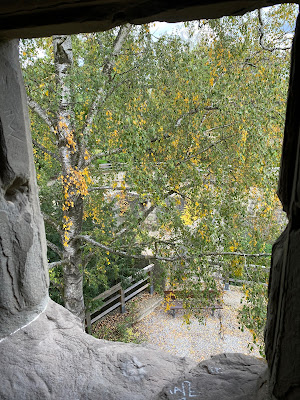





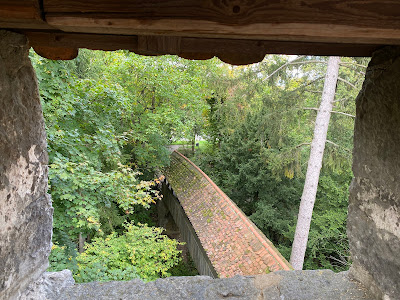


The views above the rooftops are stunning, and you get a lot of sneak peaks into peoples backyards.



















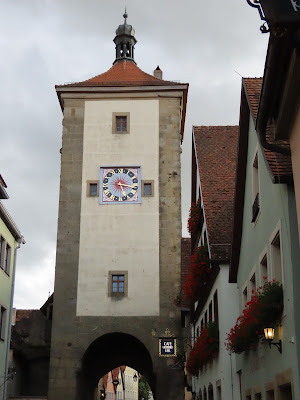






You didn't think I forgot about the signs did you?
Signs signs signs





























Yes that's a Lindt chocolate store  This little bear actually blew bubbles
This little bear actually blew bubbles



The other thing that Rothenburg ob der Tauber is famous for, is that it's home to the Käthe Wohlfahrt Christmas stores.





Did Norine buy so many snowman related items from there that we had to ship them home,
because they wouldn't fit in our luggage?
I guess you'll never know. ![]()





Our final sight of the day was the Ratstrinkstube, or Councilor’s Tavern. The building’s clock tower chimes every hour on the hour between 10 a.m. and 10 p.m., and two doors open on either side of the clock face to reenact the legendary story of the brave mayor who drank nearly a gallon of wine in order to save his city.
The famous “Legend of the Master Draught” is said to have occurred in 1631, during the Thirty Years' War. The town was seized by the imperial army led by a man named Count Tilly. Count Tilly was going to destroy the town, plunder the citizens, and execute many of the residents. The town tried to placate Count Tilly. They begged him for mercy. They tried to bribe him. All pleas fell on deaf ears. Finally, at the Ratstrinkstube, the town offered him a huge tankard of the best local wine. This succeeded in changing his mood.
As Count Tilly drank from the tankard, which held 3.25 liters of wine (.85 gallons), he thought it would be funny to toy with people and challenged the townsfolk that if they could drink the entire tankard all in one drink without stopping, he would spare the town, but he would execute anyone who failed.
The mayor of the town, a man named Bürgermeister Nusch, bravely agreed to the challenge and successfully drank the entire tankard in one draught. Count Tilly was sufficiently impressed, and good to his word he left the town unharmed. The town was saved! The townsfolk were clearly so proud of the drinking capabilities of their mayor they continued to tell the legend. In 1881, a play was written based on the story, and every year since the town has held a reenactment of the proud event during the local festival, in which hundreds of citizens dress up and celebrate the Master Draught.
Another mini reenactment takes place each hour on the Ratstrinkstube clock tower, which itself dates back to the 17th century. On the strike of the hour, two doors open next to the clock. Out of one door comes a man in cavalier dress representing Count Tilly, and out of the other door a sober man dressed in black representing the austere Mayor Nusch with a cast iron liver. The mayor lifts a giant tankard up to his lips, where it stays while the clock chimes.




Having seen the town saved again, it was time to board our bus and head back to the boat.


Tonight's entertainment was a violinist named Magda... she played amazing renditions of the Bond theme, can you feel the love tonight, a tango, Celtic Thunder, etc. She played as we left one lock, then at the next lock, she had to jump off the boat.


After our previous few nights we let the staff finish early and didn't stay up and close the bar that night.
October 9
We woke up to a very foggy morning, but an hour later and it started clearing up.


Wertheim, Germany
We had to have an early breakfast as we were getting an early start because today we would be visiting two different towns. We would disembark our boat in Wertheim, and re-board in the town of Miltenberg. They are only 30 minutes apart, but it's a little disconcerting when you see your boat pulling away..





After a rather dreary guide the day before, today's guide Christine was a breath of fresh air. She was poking fun at her husband, making jokes, and providing both thoughtful insight, and personal stories to make our visit much more memorable.


Christine showing us past flood levels indicated on the door frame dating back to 1595
Wertheim was founded between the 7th and 8th century, and is is best known for its landmark castle and medieval town centre. Built in the 12th century, the castle is perched regally on the crest of a hill above the valleys of the Main and Tauber rivers. The castle was steadily developed and enlarged until into the 17th century. It was partially destroyed by a powder explosion in 1619 and heavily bombarded during the Thirty Years' War, so that only the ruins of the Hohenstaufen dynasty castle remain standing today.




The tower known as Spiter Turm has seen centuries of flooding which has caused the tower to lean. Flood levels are marked on the outside. Apparently it was used as a watch tower and a prison for drunks and bickering women. The door was halfway up the tower, and they were tossed in where they couldn't disturb the townspeople.



It really is quite a cute town, with many unique shops and buildings, unfortunately because it is Sunday, almost every one of those stores are closed.










The Engelsbrunnen ("Angels' well") from 1574 was built of the red sandstone typical of this area and derives its name from two little angels holding Wertheim's coat of arms.


The foundation stone for the Gothic Evangalische Stiftskirche was laid in 1384. The three-aisled pillar basilica was built on the foundations of a Romanesque church. Two clocks can be seen on the clock tower, one with an hour hand only, for the residents of the castle.






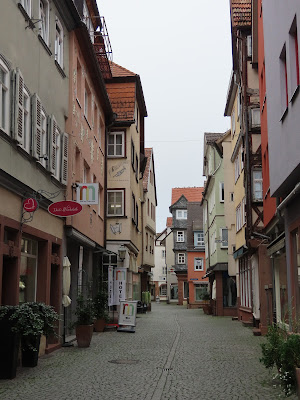








This unique home (which is now a B&B was said to have been a Witches home. From 1626 to 1631, one of the largest mass witch trials and mass-executions seen in Europe, took place in Germany.


They also had some great signs in Wertheim.













In front of some shops we came upon a row of stumble stones, Christine shared a very personal story about her father...
When he was a child, there were some other young children in the town that he played with. When the Nazi regime grew he continued to play with them, and the Nazi soldiers told his father that if he didn't stop playing with them that their family would be imprisoned because they were Jewish children. He continued to play with them, and when the other townspeople stopped selling them food and goods, he would sneak food and necessities to their families.
One day, they were all just gone. Many years later he was contacted by a family now living in Canada who was one of those children. They wanted to thank him for always being friendly and continuing to show compassion for them during those times. He told them he had to, they are all human beings. To this day they stay in contact and come to visit him every few years.

There may have been a few moist eyes as we boarded the bus and headed to our second town of the day.
Miltenberg, Germany
Dating to 1237, this small Bavarian city of Miltenberg is one of the rare German town
that wasn't reconstructed after World War II.
Best known For Half-Timbered Houses showing their age, they're beautiful and
crooked.







Gasthaus Zum Riesen, one of the oldest inns in Germany. The earliest documented mention of Zum Riesen is from 1411, which would rank it high among the oldest hotels in the world.



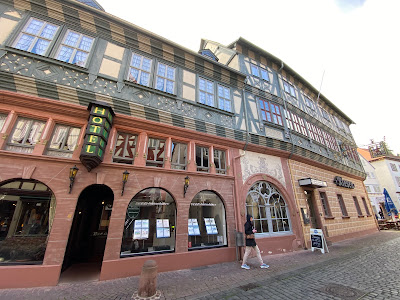

Kids are lining up past the historic Inn for a Sunday Matinee of Minions and Frozen





Of course historic Miltenberg also has some very interesting signs.









Even though they weren't open, they did have some adorable shops and cafes.








Guntram's Malerarche is a rather provocative building along the main street, we were told it was the Miltenbeg equivalent of the Red Light District in Amsterdam, but apparently it is just the home of a rather extravagant artist that obsesses over the female form.


Brauhaus Faust (Brewery) was founded in 1654, at that time still under the name Löwenbrauerei. Today, the brewery, located in the historic Schwarzviertel, is the oldest brewery in the Rhein-Main area and is run by the fourth generation of the Faust family.









Schnatterloch is Miltenberg’s famous old market square, complete with a beautiful old fountain.




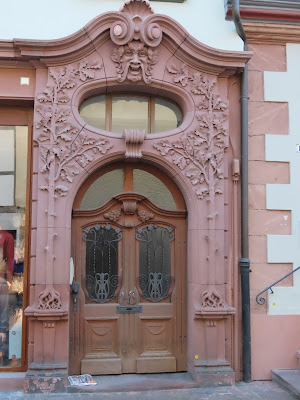


It was a shorter walking tour through the town, and the tour ended at the main square. The rest of the time we were free to shop (The shops were all closed), or we could do a hike up to the Mildenburg and lookout over the city.





Yes, that's a German guy, wearing German clothing, hiking with his German Shepard






Mildenburg hill castle was founded around 1200, but we were more interested in the views.






Having reached the overlook, our 'Hiking excursion with Emerald' was officially over, but Igor told us Odin was hiding in the wooded trails, and very few previous passengers had found it. Challenge accepted, and we headed into the trails to get a picture to prove he existed. Along with a small group of other passengers we came across these carved statues of Odin und Frigga.




A family that was hiking offered to take our groups picture, so we had evidence to show our cruise director that we actually found Odin!



Back in town, we took some time to go inside St. Jakobus (St. James Church), as it wasn't included with our walking tour.








Domfellerei harrigsbau is a beautiful ivy covered building, and as best I can tell by the sign, the building dates back to either 1480, 1803, 1831, or 1906.




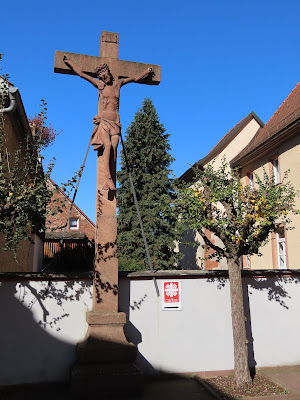

Our last stop of the day was the eastern entrance to Miltenberg’s old town, the Würzburger Tor, a defensive tower gate first mentioned in 1379. From here we met back up with the group and headed back to the boat.


It was nice to see our boat was there as we walked back to the docks at Miltenberg.


From Miltenberg we spent the rest of the day cruising the Main River past an assortment of birds, interesting buildings, and vineyards while heading to the junction with the Rhine.









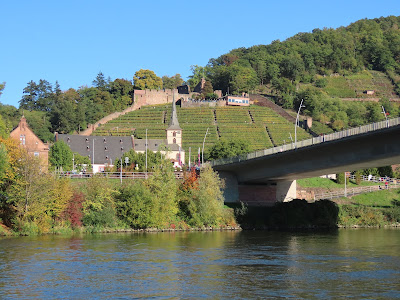



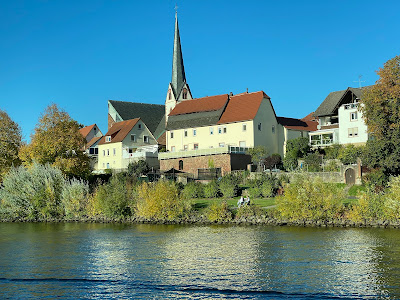










Tonights dinner was capped off with a delicious apricot flambe dessert, I was hoping it would be better than the Apricot brandy we won during trivia night, and I was not disappointed.Wolf makes a mean flambe, and reenacted it so I could get a picture.



Tonight there was two trivia games in the lounge; we came in late for Timeline Trivia, and we came in 3rd for a game called 'Would I lie to you'. It was a hilarious game where three staff members (Igor our cruise director, the head chef, and the head bartender), all told a story from their own perspective, and we had to guess who was telling the truth... we didn't even place.
Sometime during the night we passed Frankfurt and made our way to the Rhine river.


